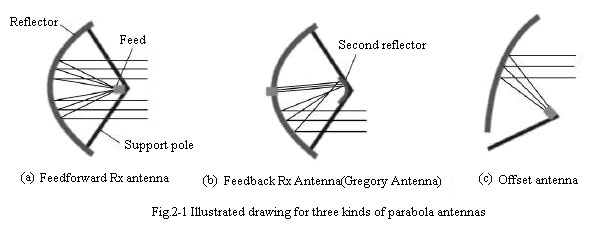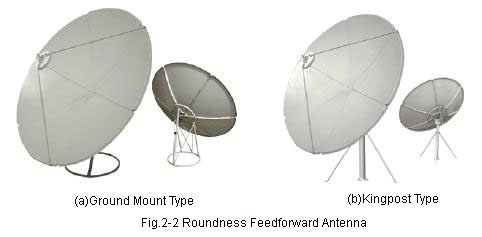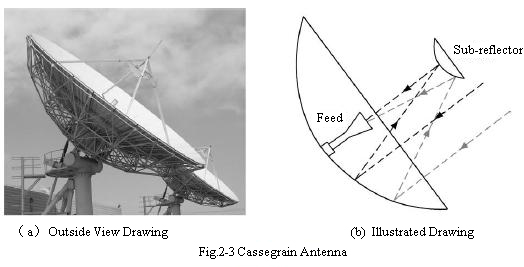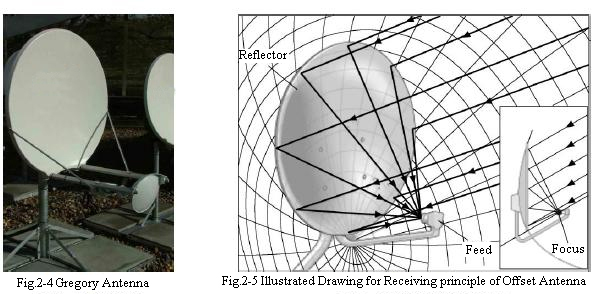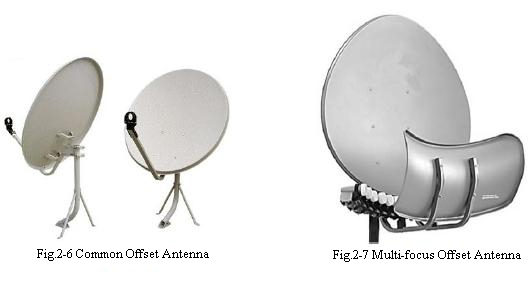Common parabolic Satellite Rx antenna consists of reflector, feed and support poles. According to the different antenna structure, that is to say, the different relative position between the reflector and feed of the antenna, we can classify the parabolic antenna as three different kinds of feed forward Rx antenna, feed back Rx antenna, offset Rx antenna. As shown in Fig.2-1
Technical Article
What is Feedforward Receive Only antenna
Feedforward antenna is also called centre focus antenna or Prime focus antenna, what is we often call "big pan". Feed locates the focus point of the parabolic antenna, Satellite signals are reflected by the antenna parabolic surface, and then these signals are focused on the feed. Generally feedforward antennas present roundness, and some present squareness, whose structures are simple. For this kind of antenna, it is convenient to do the installation and adjust the feed, so generally the diameter is within 4 meter. The diameter of common roundness feedforward Rx antenna is 1.0m,1.2m,1.35m,1.5m,1.65m,1.8m,2.1m,2.4m,3.7m,4.2m,and so on, which are often used for C-band signals.
According to the antenna fixing types, roundness feedforward Rx antenna is classified into two types, which are ground mount type and kingpost type. As shown in Fig.2-2.
What is Feed back Receive Only antenna
Feed back antenna belongs to twice-reflected antenna, there're two reflectors, and the main reflector is paraboloid. On the focus point there is a sub-reflector, which is used for reflecting the Satellite signal once again and through the waveguide tube the signal is transmitted to the LNB at the back of the antenna. The main purpose for adopting feed back antenna is to enhance the antenna receiving efficiency and improve VSWR. The highest efficiency of feed back antenna can be getting to 75%, but the highest efficiency of common antenna just can be getting to 70%. Additionally, if the user adopts feed back antenna, LNB can avoid to be affected by high temperature in the hot area; however, the structure of feed back antenna is complex and also the production cost is much higher, so generally for bigger diameter antenna, it will adopt feed back structure so as to be convenient to do the feed assembly and adjustment; and for individual receiving, feed back structure will not be used.
According to the sub-reflector shape, feed back antenna can be classified into two kinds, one is Cassegrain antenna, and another one is Gregory antenna.
(1) Cassegrain antenna
The sub-reflector of Cassegrain antenna shows hyperboloid of revolution, and the Casegrain antenna is often used for commercial earth station. As shown in Fig.2-3
Offset Receive Only antenna
A part of feedforward and feedback antenna is adopted in offset antenna; its feed and sub-reflector are deviated from the right ahead of the reflector, which can not stop the Satellite signal, so the efficiency is high, as shown in Fig.2-5. Most offset antenna reflector shows ellipse shape or die rhombus, this antenna is often used for receiving ku band signal.
There are two kinds of offset antenna, one is once-reflected antenna, and another one is twice-reflected antenna, once-reflected antenna is the common offset antenna, as shown in Fig.2-6, also called dish antenna. Its structure is simple and cost is low, generally it is used for single Satellite receiving. Common offset antenna reflector is ellipse shape, and the diameter is 0.35m,0.45m,0.55m,0.60m,0.75m,0.85m,0.90m,1.2m,1.5m,1.8m, and so on.
Twice-reflected antenna belong to multi-curved surface antenna(multi-focus antenna), as shown in Fig.2-7, its reflector use denatured spherical surface or poraboloid, like the rectangle cut from the spherical surface, or organize the reflector by two kinds of curves, where the horizontal direction is circular arc, and vertical direction is a part of paraboloid. Thus on the antenna many feeds can be installed, and the Satellite signals can be reflected into many feeds which locates on different places, each feed can receive different Satellite signals, and so receiving different Satellites signals from one set of antenna will be realized.
Main technical parameters of Receive Only antenna
To judge whether a pair of antennas is good or bad, you need some of the major technical parameters of antenna to help you. The main technical parameters of the receiving antenna include the efficiency, gain, main lobe width, and ratio of focus diameter.
- Antenna efficiency
Antenna efficiency means that the ratio of the maximum output power the antenna actually sends to the matched load and the maximum output power the antenna sends to the matched load when it is assumed lossless. Antenna efficiency is normally 40% to 70%, and the efficiency of offset reflector antenna is up to 80%.
- Gain
Antenna gain is the radiant power density of the antenna at a distance in the direction of the maximum radiation. The weaker the signal, the higher requirements is needed for the antenna gain. Antenna gain is related to the aperture and in direct proportion with the square of the antenna radius. That means the larger the aperture is, the more the gain will be. The gain is also related to signal frequency and in direct proportion with the square of the signal frequency. That means the higher the signal frequency is the greater gain will be got.
- Main lobe width
The center radiation lobe called main lobe, the rest are side lobes. It will be better if there is less and smaller side lobe. Main lobe includes the radiation lobe which is in the direction of the largest radiation. And in this direction the antenna will have the best radiation performance. The major signals for the receiving antenna are mainly from main lobe. Main lobe width means its signal reception angular region. The narrower the lobe is, the narrower the signal receiving angle will be. But if the lobe is too wide, it is likely to receive the nearby satellite signal that will cause interference. Lobe width is inversely proportional to the antenna aperture and signal frequency, so accordingly, the larger the antenna aperture, the narrower the lobe width; and the higher the frequency of the signal, the narrower the lobe width.
Half-power angle is used to reflect the width of lobe. The smaller the half-power angle is, the greater the directivity and the radiation power will be. The half-power is inversely proportional to the diameter of the antenna, but in direct proportion to the work wavelength. That is to say, the half-power angle of a small aperture antenna is comparatively large. So the antenna pointing is relatively easy. And it is not sensitive to the drift of the satellite. But the large aperture antenna is opposite, difficult of pointing and sensitive to the drift of the satellite, because of the comparatively smaller half-power angle.
- F/D
The focal length of prime focus antenna is the distance from the center of the antenna to the main focus. The normal prime focus antenna F/D is between 0.3 and 0.4. F means the parabolic focus of the antenna, and D means the diameter of the antenna actinal surface. According to the mathematical calculation, when F/D=3.8, the performance of the rotating parabolic reflector antenna is the best. So the common finished prime focus parabolic reflector antennas are mainly taking F/D=3.8.


